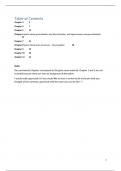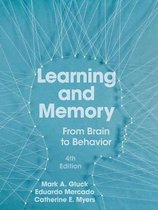Table of Contents
Chapter 3 2
Chapter 4 7
Chapter 5 13
Chapter 6 (parts about generalization and discrimination, and hippocampus and generalization)
19
Chapter 7 21
Chapter 8 (parts about brain structures – basal ganglia) 28
Chapter 9 29
Chapter 10 36
Chapter 12 42
Note:
the summarized chapters correspond to the given exam material. Chapter 1 and 2 are not
included because these are seen as background information.
I would really appreciate it if you would like to leave a review to let me know what you
thought of the summary. good luck with the exam you can do this! 😊
1
, 3 - Habituation, sensitization, and familiarization
3.1 Behavioural processes
Learning: the process by which experiences can lead to changes in behaviour. Changes are not always
obvious. In Latent learning no initial indications of changes in behaviour take place. Learning and
recognition are hidden from the world.
Recognizing and responding to repetition:
Habituation: A decrease in the strength or occurrence of a behaviour after repeated exposure to the
stimulus that produces that behaviour.
General features of Habituation:
Acoustic startle reflex: A defensive response (such as jumping or freezing) to a startling stimulus (such
as a loud noise). When a sound is repeated, the startle response will decline (habituation).
Orienting response: An organism’s innate reaction to a novel stimulus/important event (in infant
research). The duration of staring is called fixation time, this decreases with repeated presentation of
the stimuli. Habituation can be effective (save of energy) but also dangerous (gunshots/fire alarms).
Stimulus specificity and dishabituation:
Habituation is stimulus specific. Renewal of response to a new visual stimulus. For example, new
mating response in rats after showing new partner or longer fixation time in infants after showing a
new picture.
A renewal of a response, previously habituated, that occurs when the organism is presented with a
novel stimulus is called dishabituation. Dishabituation often occurs when an arousing stimulus (like a
kitten) is introduced into a sequence of otherwise monotonous repetitions.
Factors influencing the rate and duration of habituation:
How rapidly a response habituates and how long the decrease in responding lasts depend on several
factors. How startling the stimulus is, the number of times it is repeated and the lent of time between
repeated exposures. The less arousing an event is, the more rapidly a response to that event will
habituate. More habituation is shown after earlier repetitions > later exposures. More rapid
repetition of a stimulus leads to more rapid habituation. Exposures can be repeated close together
(massed) or spread out over time (spaced).
Habituation does not last forever. Habituation that goes away in seconds or minutes is called short-
term habituation; habituation that lasts longer is called long-term habituation. Reappearance (or
increased strength) of a previously habituated response after a short period of no stimulus
presentation is called spontaneous recovery. A stimulus is faster ignored after massed exposures >
spaced exposures. But after a longer period, individuals that received massed exposures are more
likely to show spontaneous recovery.
Habituation is not a temporary effect, but habituation effects accumulate over time. E.g., when
showing a picture of a donut to an infant, their response will decrease over time. Showing the same
picture one day later will probably show spontaneous recovery. However, this time the habituation
needs less trials to occur. This shows effects of earlier repeated experiences have not faded away.
mechanisms underlying habituation continue to change with repeated exposures, even when
behavioural responses are no longer changing. Learning like this, without observable changes in
2
,behaviour, is called latent learning. E.g., even when a rat does not show a response to a sound,
repeating this sound may still lead to delayed spontaneous recovery.
General features of sensitization:
Sensitization is a phenomenon in which a salient stimulus (such as an electric shock) temporarily
increases the strength of responses to other stimuli. In some cases, one exposure is enough, in other
cases more exposures are needed. Typically, fewer exposures are necessary to produce sensitization
than to produce habituation. Whereas habituation is stimulus specific, sensitization is not.
Researchers can study sensitization by measuring electrodermal activity (EDA). EDA are the
fluctuations in the electrical properties of a person’s skin that are a consequence of activity in the
peripheral nervous system. E.g., an exposure to a loud noise will cause a largen change in EDA (due to
fear).
The effect of sensitization can be reversed by reversing the loud and quite tone. This effect is called
Prepulse inhibition/desensitization. Hearing a quite noise before the loud noise will lead to reduced
responses (like habituation). Prepulse inhibition is like sensitization in that: (1): initial stimulus can
affect responding to a wide range of stimuli, and (2): a single presentation of the weak stimulus can
produce the effect. The state of an organism can play a large role in what it learns from repeated
events.
Dual process theory:
Dual process theory suggests that habituation and sensitization are independent of each other but
operate in parallel. The effect of repeated events is decided by the interplay of processes underlying
sensitization and habituation. Boring repetitions can lead to habituation, while arousing repetitions
lead to sensitization. The sum of these two independent processes determines the strength of
responding.
Opponent process theory:
Experiencing an event can lead to two emotional processes: one pleasurable and one that is less
pleasant. The overall emotion a person experiences is the sum of these two processes. Your initial
response (fear) will habituate faster than the rebound (thrill). Different from dual process theory: (1):
the rebound, which is directly triggered by the initial emotional response (2): both underlying
processes are associated with emotional arousal. Like dual process theory: (1): learning that results
from repeated experiences is not simple. (2): repeated experiences change not only the response but
also perception and interpretation of events.
The what and where of learning from exposure:
Recognizing familiar objects:
Novel object recognition task: a task in which an organism’s detection of and response to unfamiliar
objects during exploratory behaviour are used to measure its memories of past experiences with
those objects. Som animals avoid novel objects, called neophobia. The perception of similarity that
occurs when an event is repeated is known as familiarity.
Priming:
Priming is a phenomenon in which prior exposure to a stimulus can improve the ability to recognize
that stimulus later. This is studied in the word-stem completion task in which participants are asked to
fill in the blanks in a list of word stems to produce the first word that comes to mind. In a priming
experiment, participants are more likely to produce a particular word if they have been exposed to
that word previously. Priming in blue jays: they are better able to detect a moth if it is similar to a
recently detected one.
3
, Perceptual learning:
Perceptual learning is learning in which experience with a set of stimuli makes it easier to distinguish
those stimuli. Rat experiment: rats exposed to circles/squares were better at distinguishing between
the shapes after exposure. Twice as much exposed to the similar features of the shapes giving
more attention to the different features better at distinguishing. Here latent learning took place.
There is no behavioural evidence that they have learned. Perceptual learning without explicit training
is called statistical learning.
Similar to priming: both lead to more effective processing of the stimuli. In addition, both can happen
without being aware. Different from priming: perceptual learning is long-lasting whereas priming has
short-term changes.
Spatial learning:
Spatial learning is the acquisition of information about one’s surroundings. Rat experiment: rats were
put in a maze with a food box. After several exposures, the rats were able to find the food box with
fewer errors. Another group of rats were put in the box without food being present. They first explore
the maze. After adding the food, they could very easily navigate to the food (even better than the first
group). Wasp experiment: placed pinecones around a wasp’s burrow. After replacing these pinecones
(after multiple exposures) the wasp’s searched for its burrow withing the ring of (replaced)
pinecones.
3.2 brain substrates
Cortex is critical for habituation and it actively suppresses reflexive orienting responses to stimuli
perceived as familiar. However spinal cats still showed habituation to tactile stimulation. This proved
that the spinal cord by itself contains all the neural machinery necessary for habituation (cortex/rest
of brain is not needed).
An invertebrate model system:
Aplysia breathe through gills. A structure called the siphon blows aerated water of the gills to assist
respiration. When in danger the gills are retracted under the mantle (gill-withdrawal reflex). Sensory
neuron S fires release of glutamate motor neuron M fires gill muscle.
Habituation in Aplysia:
If neuron S is activated repeatedly, it gradually releases less glutamate, thus decreasing response of M
(synaptic depression = reduction in synaptic transmission). Habituation in Aplysia is homosynaptic,
which means that it occurs in one synapse without affecting nearby synapses (T/U). synaptic
transmission in Aplysia can be depressed by both decreases in neurotransmitter release and
elimination of synapses.
Sensitization in Aplysia:
An adverse tail shock sensitizes subsequent responding, such that a weak touch to the siphon now
produces a strengthened gill withdrawal. On neuronal level it works as follows: a tail shock activates
motor neuron M motor response T and a tail shock activates interneuron I N which delivers
serotonin to axons of neurons S and U activation neuron S causes a larger release of glutamate
greater activation of neuron M than previously.
Sensitization in Aplysia is heterosynaptic, meaning that it involves changes across several synapses.
Because of this a tail shock increases responses to any future stimulus.
Dishabituation seems to involve active inhibition of synaptic transmission by an independent set of
inhibitory neurons.
4






